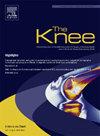股骨和胫骨骨矿密度的差异与膝关节骨性关节炎晚期患者的胫骨变形有关
IF 1.6
4区 医学
Q3 ORTHOPEDICS
引用次数: 0
摘要
背景本研究调查了膝关节周围的骨矿密度(BMD),以明确终末期膝骨关节炎(KOA)患者胫骨变形超过股骨变形的机制。术前使用双能 X 射线吸收仪(DXA)测量股骨颈和股骨总的 T 值,并使用计算机断层扫描(CT)测量股骨远端和胫骨近端的 hounsfield 单位(HU),以评估 BMD。HU的测量方法是将股骨和胫骨分别分为内侧、外侧和总段。胫骨近端内侧角(MPTA)≥85°的患者被视为 "第1组",MPTA < 85°的患者被视为 "第2组"。结果 胫骨近端 HU 低于股骨远端(股骨外侧;股骨内侧;胫骨内侧;胫骨外侧)。第 2 组的 T 评分(股骨颈、股骨全长)和 HU(股骨外侧、股骨全长、胫骨外侧)均低于第 1 组。结论 KOA曲位终末期的胫骨内侧塌陷比股骨内侧塌陷严重,这与胫骨近端 BMD 低于股骨远端 BMD 有关,而且 MPTA 塌陷受 BMD 绝对值的影响,而不是受股骨-胫骨 BMD 差异的影响。本文章由计算机程序翻译,如有差异,请以英文原文为准。
The difference in bone mineral density between femur and tibia is related to tibia deformation in endstage knee osteoarthritis
Background
This study investigated bone mineral density (BMD) around the knee joint to clarify the mechanism by which tibia deformation exceeds that of the femur in patients with end-stage knee osteoarthritis (KOA).
Methods
We retrospectively analyzed 193 patients who underwent total knee arthroplasty for end-stage KOA with varus alignment. Preoperative T-score of the femur neck and femur total using dual-energy X-ray absorptiometry (DXA) and hounsfield units (HU) of the distal femur and proximal tibia using computed tomography (CT) were measured to asess the BMD. HU was measured by dividing the femur and tibia into medial, lateral, and total parts, respectively. Patients with medial proximal tibial angle (MPTA) ≥ 85° were considered ‘group 1′, and MPTA < 85° were ‘group 2′. The HU between femur and tibia were compared in group 1. T-score, HU, and HU difference between group 1 and group 2 were compared.
Results
The HU of the proximal tibia was lower than that of the distal femur (femur lateral > femur medial > tibia medial > tibia lateral). T-score (femur neck, femur total) and HU (femur lateral, femur total, tibia lateral) were lower in group 2 than in group 1. There was no difference in femur-tibia HU difference between groups.
Conclusion
The medial tibia collapse more than the medial femur in varus endstage KOA was associated with the lower BMD of the proximal tibia than that of the distal femur, and the MPTA collapse was affected by the absolute value of BMD rather than by the femur-tibia BMD difference.
求助全文
通过发布文献求助,成功后即可免费获取论文全文。
去求助
来源期刊

Knee
医学-外科
CiteScore
3.80
自引率
5.30%
发文量
171
审稿时长
6 months
期刊介绍:
The Knee is an international journal publishing studies on the clinical treatment and fundamental biomechanical characteristics of this joint. The aim of the journal is to provide a vehicle relevant to surgeons, biomedical engineers, imaging specialists, materials scientists, rehabilitation personnel and all those with an interest in the knee.
The topics covered include, but are not limited to:
• Anatomy, physiology, morphology and biochemistry;
• Biomechanical studies;
• Advances in the development of prosthetic, orthotic and augmentation devices;
• Imaging and diagnostic techniques;
• Pathology;
• Trauma;
• Surgery;
• Rehabilitation.
 求助内容:
求助内容: 应助结果提醒方式:
应助结果提醒方式:


